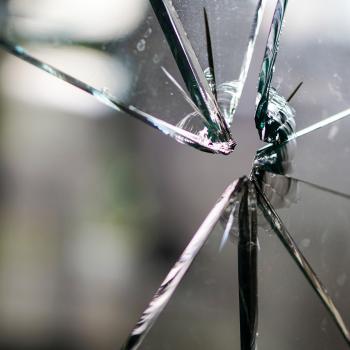I spent about 30 minutes composing a blog post that was mostly disjointed thoughts about career discernment. I was at Borders. Then, most inexplicably, something happened to the internet connection and poof! — my post was gone.
I then had quick dinner and a planning meeting for 40 Days for Life, which I am helping out with this fall. SO, I haven’t had time to sit down and try to recapture the thoughts I had down here this afternoon. I think that ship has sailed.
So instead, I am going to post part 1 of my thesis. Be forewarned, it’s long. But please do let me know if you get to the end, and what you think of it! Since I am graduating from a professional school, our thesis is in the form of a case study and research solution.
Voila!
Practical Pro-Life Implications for Catholic Universtities
Case Study: Kathleen F.
During my junior year of college, I was a Resident Assistant (RA). I lived on a floor with 60 women; it was my job to be a resource person, companion, and friend to those who lived on my floor. As an RA, I received extensive training around a myriad of situations and possible issues. However, one of the situations we never received any training about was what to do if a resident found herself (or a male resident found his girlfriend) in an unplanned pregnancy. Yet, this situation is exactly one that I was faced with during my first full year as an RA.
Kathleen was a sophomore accounting major. She was from a small town in Maryland, about 2.5 hours from our campus. She had a single room on our floor and was involved in a few clubs and groups on campus. She came to a few hall programs, so I had gotten to know her a little bit more than some of the other women on the floor. One day in November, Kathleen came to my room in the afternoon when I was working on a paper. She was visibly upset. We started talking and she told me she was pregnant. She didn’t know how far along, because she hadn’t been to a doctor; she had just taken two pregnancy tests, both of which read positive.
I had no idea what to do. I knew I had to help her figure out what to do next; but I had never been in this situation and never received any training on how to handle it if it came up. I called the campus health center and made an appointment for her the next day. I talked with her that day to find out more about the situation; her boyfriend was the father, she was sure. She figured she’d tell him after she knew more, and thought about what to do. The next day, I walked to the campus health center with her and waited for her during the appointment. She came out and we talked.
Her sister had had an abortion a few years earlier and she said, “It messed her up”, so she was not going to have an abortion, regardless of what her boyfriend said. But there were a lot of unanswered questions; Could she be covered under college health insurance while pregnant? Was there housing available for her while pregnant; while parenting? Was there any special assistance available to her in terms of financial aid, resources, or accommodations in coursework? Would there be childcare available after her baby was born? Could she finish college and have her baby?
Kathleen’s family and boyfriend were supportive of her decision; but upon investigating the college policies regarding pregnant students and those with young children, it became somewhat clear that our college was not supportive of her decision. In words they were, because our school is known for being a very ‘pro-life’ atmosphere. However, when it came down to policies that made it easier for students like Kathleen to choose life, there didn’t seem to be many.
Kathleen ended up leaving our college, because there was no housing available for her once her baby was born (unless she and her boyfriend got married, which they were not ready to do), and her parents, who agreed to take in her and the baby, lived too far away for her to commute several days a week. The lack of childcare on campus also contributed to her decision to leave school. The last time I spoke with her (about two years ago) she was going to school part time close to home in order to finish her degree, and was the primary caregiver to her son, Charlie. Her boyfriend remained supportive of her and often visited his son on breaks and during the summer. He also finished his four-year degree on time and graduated from our college in 2007.
Social Analysis:
I’ve gone back to Kathleen’s story several times over the past few years, especially when I began working as a pregnancy counselor in fall of 2007. I have heard stories similar to hers since beginning that work, but now, I have the resources at my disposal to help other women be able to balance education (or work) with a choice of life for their babies and themselves. I wish I had been able to help Kathleen more; I wish the administration of my college had helped Kathleen (and the others in her situation) more.
Part of the reason why I used to consider myself pro-choice was because I never wanted to see a woman put in the position of having to choose between finishing her education or having a child because of an unplanned pregnancy. I still feel that way. However, what has changed is my belief about what the best way to address the situation is. Abortion places a heavy burden on women; it asks them to sacrifice, it requires them to lay their bodies down and sacrifice their child for the sake of their education. Abortion requires nothing from society, other than its approval.
Instead of telling women, “If you get pregnant unexpectedly, you get to choose between having an abortion and staying in school, or having your baby and dropping out”, we should be challenging the structures in our society that make those the only two options available to women. In Kathleen’s situation, she was required to make that choice, and she chose life at the expense of finishing her education on time. Her boyfriend, the baby’s father, was not required to make such a choice. He was free to be a supportive father and continue living on campus, and ultimately finish his education on his terms. Women deserve the same opportunity.
Work on this subject has been undertaken, most notably by the organization Feminists for Life, who work on addressing the root causes that drive women to seek abortions. I will be borrowing heavily at times from their ideas and work, but will focus this writing on Catholic colleges and universities, for several reasons. Primarily, because the two universities I have attended personally were Catholic, so this is the framework that I operate out of. Also, Kathleen’s story, which will serve as a reference point throughout the paper, took place at a Catholic university.
And, lastly, but not without importance, Catholic colleges and universities have a special calling, opportunity, and responsibility in this regard. As institutions of higher learning that identify as Catholic, we know that part of what it means to be Catholic is to embrace an ethical view of the world that consistently upholds and respects the life and dignity of the human person in every stage of life. As such, our Catholic colleges and universities should be the shining examples for others of places where students who face unplanned pregnancies find the support and resources to make it easier for them to choose life for their children and themselves. In highlighting this, I make the claim that the majority of Catholic universities have not been worse than their secular counterparts, but they also have not been better.
The unjust structures that make it harder for women to choose life and choose education will be examined through the lenses of social, economic, and political sciences, as well as biblical and religious traditions, including Catholic social teaching. The following questions and analyses have been raised through research and reflection on the case study presented above.
This situation must be understood in a broader context of the society we live in. We live in a society that sees people and the relationships they entail as burdens, not blessings. Elderly citizens, people with mental and developmental disabilities, criminals, the chronically poor and unemployed, “unwanted” babies and children; all of these groups of people have in common the fact that they have become throw-away people. They’ve become humans who do not matter, and since they are either inconvenient or require extra effort on the part of individuals and society, they must be killed or pushed so far to the margins of society that they may as well be dead. Unborn children are certainly casualties of this societal mindset, but they are definitely not the only ones.
Obviously these spheres -culture, politics, economics – affect each other drastically, and it doesn’t make sense to speak of any one as independent of the others. Our political system is largely unwilling to support women in unplanned pregnancies financially because society views those women and children as expendable and unworthy of the investment of time and money they require. Their humanity is overlooked in a grotesque cost-benefit analysis. Women live in poverty in rates much higher than men do because we have a market system that expects women to behave as men in order to get ahead. All of these patterns and institutions of our society create a vicious cycle of indifference and contempt for women – especially college-aged women – who find themselves in unplanned pregnancies.
Kathleen’s story raises many serious questions, which will be addressed in depth in section two of the paper. Some of these questions include: Why should a college-aged woman be encouraged not to have an abortion if she becomes pregnant?, What does our Catholic Tradition and Scripture have to say about this situation?, How can we begin to build a culture and society with structures of grace for all women who find themselves in unplanned pregnancies?, What role should Catholic Universities play?
That’s all folks! (for part 1)
—










